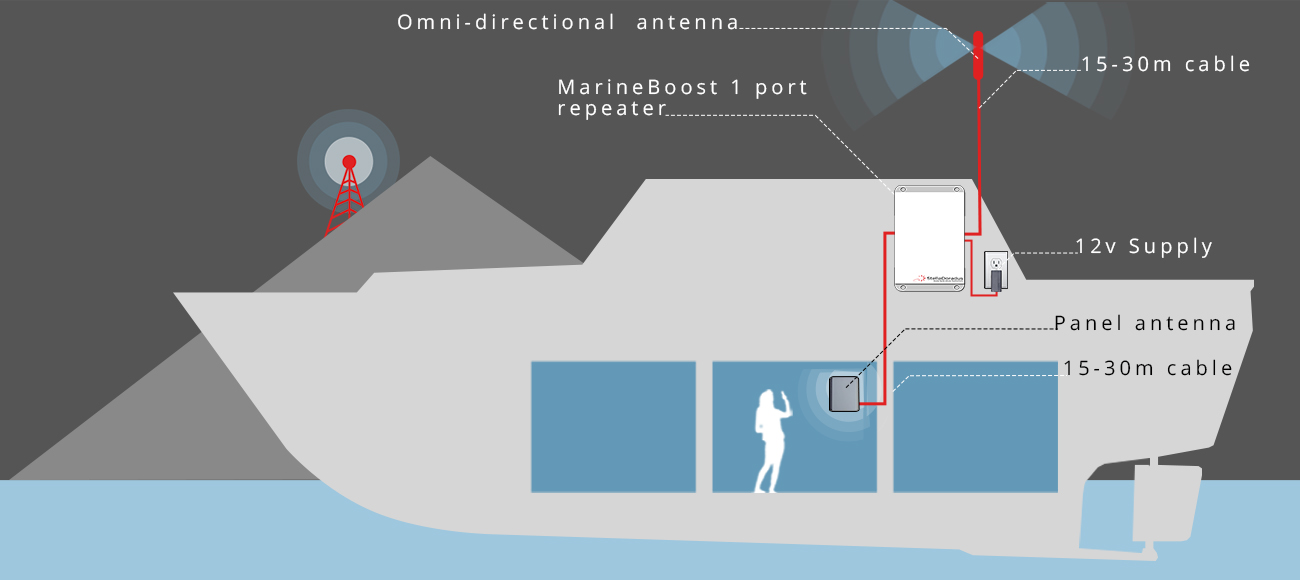€ 1.275,20 excl. BTW
MarineBoost 5.1 marine signal repeater Kit
MarineBoost 5.1 marine signal booster for small ships| 1000M2 coverage







- Networks: GSM, 3G, 4G (all frequencies)
- Coverage: ~5 rooms/areas
- Frequency: 800 + 900 + 1800 + 2100 + 2600Mhz
- All mobile operators boosted
- Ce certified and RoHS
- No need for existing broadband connection
- Unlimited number of calls / data sessions at the same time
- Complete operator network protection.
Works for:





|
€ 1.320,00
(€ 1.090,91 ex-BTW)
- Description
- Specification
- Reviews

How it the marine signal booster works:
The omni-directional antenna is installed on the ship outside and it receives the signal from all operators 360 degrees around the ship. It sends this signal down the cable to the Marineboost 5.1 repeater. The repeater amplifies the signal and re-transmits it into the area where you want coverage.
Mobile phones, tablet / laptops in that area then communicate with the improved reception. When a mobile device transmits, the signal is received by the indoor antenna, amplified by the MarineBoost and transmitted back to the operators base station through the outdoor antenna.
Use of the omni-directional antenna eliminates the need to point the antenna in the direction of your operator as it will receive the signal from all directions. The signal strength indicator on the repeater lights up as the signal is received. This shows you how strong your signal is.
With this repeater, you amplify all 5 mobile signal bands. That 800,900,1800,2100 and 2600Mhz respectively.
Networks : GSM + 3G + 4G

The theoretical maximum distance out to see that the repeater can amplify a signal is 30km.
The MarineBoost 5.1 signal booster works with all mobile operators, so once installed you can be assured that everybody’s mobile reception will be amplified on the boat. The repeater receives all signals from all mobile masts within a 30km distance on the coast.
The MarineBoost 5.1, 5 band 1 port kit includes:

- One MarineBoost 5.1 repeater
- One outdoor omni-antenna
- One indoor antenna
- One power supply
- 15m length of SD400 coaxial cable
The frequencies explained:

800Mhz
800Mhz is one of the frequencies that 4G uses. This frequency is excellent for propagating about the countryside. Most mobile operators use 4G at 800Mhz in rural locations.
900Mhz
900Mhz is used for the GSM network. GSM is a robust standard used by your phone and the operator’s base station to transmit voice signals. It has been about for a long time which is a testament to how successful it is. All phones, including the older “non-smart” phones can use this standard. 900Mhz is a relatively low frequency that is excellent at propagating through the countryside. It is most likely that this frequency is available outside your house (Can you make calls outside your house?). It also uses much less power then 3G or 4G. ie, your phone battery lasts longer!
1800Mhz
1800Mhz is a mid range frequency. Most operators transmit GSM and EDGE data at 1800Mhz in cities. EDGE data is low bandwidth and is only suitable for emails. Many mobile operators use 1800Mhz for 4G also.
2100Mhz
2100Mhz is used by all mobile operators for the 3G network. This is available in all cities and offers very fast data speeds. It is also available in many parts of the countryside but you should always check outside your property to see if you can receive this frequency on your phone. Generally, if you can browse the internet on your phone outside your property, it is likely you are on 2100Mhz, 3G.
2600Mhz
2600Mhz is used for 4G in cities. This frequency is ideal for offering high speed broadband (even higher than 3G). This frequency is used in cities mainly.
€1,320
(€1073.17 ex-BTW)

 In stock, ready to ship
In stock, ready to ship


